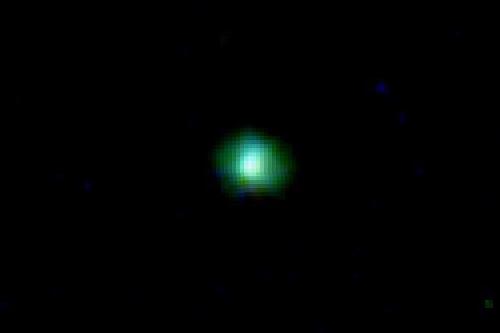
The light from Maisie's Galaxy, detected by the JWST CEERS program, was emitted only 390 million years after the Big Bang, during the epoch of reionization. Credit: NASA/STScI/CEERS/TACC/The University of Texas at Austin/S. Finkelstein/M. Bagley.
In astronomy, we take pictures of the past. Because light from distant galaxies can take billions of years to reach us, when we take an image of a distant galaxy, we see it as it looked billions of years ago. The farther away the galaxy, the farther back in time we’re looking. We use these snapshots in time to build a picture of how the universe evolved. Observing the most distant galaxies is exciting but also challenging. Astronomical objects that are distant are also fainter and can be harder to detect or study in detail. As light travels across the universe to reach us, it also gets stretched by the universe’s expansion to redder wavelengths, which can make certain parts of the electromagnetic spectrum harder to observe. Gas clouds located along the light’s long path can also absorb the light, preventing it from ever reaching Earth. This absorption is particularly problematic for high-energy ultraviolet photons.
By observing rare, highly star-forming, nearby galaxies that resemble these more distant galaxies, we can study otherwise inaccessible wavelengths of light or properties that would be difficult to study in detail. In my research, I focus on understanding the high-energy ultraviolet light produced by massive stars in these galaxies, how these massive stars influence their surrounding interstellar gas, and whether and how their light escapes into intergalactic space. These processes can help us understand galaxy evolution and the epoch of reionization, a time in the first billion years after the Big Bang when early galaxies ionized the universe’s hydrogen gas. To investigate these questions, my students and I have used multi-wavelength observations, including ground-based optical spectroscopy, ultraviolet spectroscopy with the Hubble Space Telescope, and mid-infrared observations with the James Webb Space Telescope.

The light from Maisie's Galaxy, detected by the JWST CEERS program, was emitted only 390 million years after the Big Bang, during the epoch of reionization. Credit: NASA/STScI/CEERS/TACC/The University of Texas at Austin/S. Finkelstein/M. Bagley.

A Hubble Space Telescope image of a much closer, "Green Pea" starburst galaxy, whose light was emitted 11.3 billion years after the Big Bang. Like many galaxies in the early universe, Green Pea galaxies are compact, highly star-forming, and deficient in heavy elements. Credit: NASA/STScI/A. Jaskot.
To learn more about the epoch of reionization, check out our recent results from the Low-redshift Lyman Continuum Survey, a 134-orbit program with the Hubble Space Telescope that represents the largest survey of escaping ionizing radiation from nearby galaxies.
Also on this site, you can learn about student research opportunities, view my CV and latest projects, and find out how to contact me.